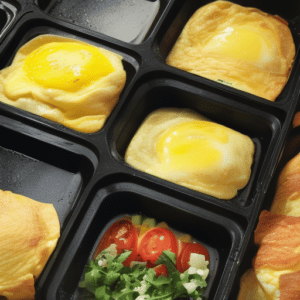

Omelettes are a highly versatile food that can be delicious when made correctly. However, they can be tricky to make in a traditional saute pan, especially for inexperienced home cooks. Even if you know how to make omelettes in a pan, an omelette maker can make the process significantly more straightforward and convenient. With a few simple instructions and a basic understanding of both the appliance and the procedure, anyone can operate an omelette maker.
We compiled this handy guide to help you use your omelette maker to your ability. So keep on reading to learn how to use an omelette maker like a pro, and you’ll be eating cooked, delicious omelettes in no time.

As with any new appliance or kitchen tool, we recommend reading the user manual before actually firing it up for use. While we made a point to bring you a comprehensive how-to guide, this will alert you to specific traits and controls on your omelette maker. It will also give you a more precise cooking time and more precise recipe proportions and may even give you some good breakfast, lunch, and dinner ideas that expand beyond just making omelettes.
Once you have familiarized yourself with your omelette maker, it is time to choose an omelette recipe and gather all of the ingredients and supplies you will need. Basic omelette-maker recipes only call for two to three eggs, salt, and pepper, but you can get quite creative with recipes for omelettes. Still, if you are unsure, you can start simple and perhaps add some cheese and parsley for a garnish.
Aside from the ingredients, your omelette maker, and a power outlet, you won’t need much else to get the job done.
To start, plug in and turn on your omelette maker. Most omelette makers only have one heat setting, so you won’t have to make any adjustments. Typically, an indicator light will turn on when you plug in your device and then turn off when the appliance is preheated to the ideal temperature.
However, if you are using a stovetop omelette maker, place it on a hob burner and switch it to medium-low heat.
Next, crack two or three eggs into your small mixing bowl. Two eggs are typical for one serving if you add other filling ingredients but don’t add them just yet. Using your whisk or fork, thoroughly whip the eggs.
Mince any other fillings like meats, vegetables, herbs, or cheese. Then, mix them into your eggs and add salt and pepper to taste.
Open your omelette maker and spray the cooking plates with non-stick spray. When opening, use the handles as the outside of the appliance will be hot. You can also grease the cooker plates with butter or oil using a pastry brush, but we like to use the spray because it is often the easiest and quickest option.
Almost all omelette makers feature non-stick cooking plates, and they may even boast that there is no need for spraying before use. However, we have found removing omelettes much easier overall, so we strongly recommend adding some grease before you pour your omelette mixture inside.
Fill the lower hot plate area about half of the way up with your egg mixture. Please remember not to fill your omelette maker more than half full because they can overflow easily. If otherwise, there will be a waste of ingredients. The worst-case scenario is creating a hot and sticky mess that could burn you.
When using a countertop omelette maker, which most households use, you can always place the machine on a cutting board or baking sheet to catch any overflow until you get the proportions down and are confident it will not overflow.
Close the lid on your omelette maker and wait for the indicator light to alert you when your omelette or omelettes are ready. Most omelettes will take about four to five minutes to cook.
If you are using a stovetop omelette maker, cook your omelette on the first side for two to four minutes, depending on how many eggs and other ingredients are being used and how well done you like your eggs. Two to three minutes is most common. Then, flip the omelette maker and allow your ingredients to cook for one more minute, and your omelette should be done.

When your omelette is done cooking, open your omelette maker up and extract your fresh omelette or omelettes. Take care to use the handles and be mindful of any escaping steam.
If you are unsure if your omelette is cooked to your preferred consistency, you can always take a peek inside the lid and test it with a knife to make sure it is cooked according to your preference. Just cut a slit in the omelette to make sure it is cooked through.
Once you are sure your omelette is ready, unplug your omelette maker and use a spatula safe for non-stick cooking surfaces to extract your omelette. Then, garnish it with anything you like – we like cheese! – and serve it hot.
If you are using a stovetop omelette maker, lift the top, be careful of any hot steam escaping, and slide your omelette out and onto a plate.
Once your omelette maker is completely cool and you are done enjoying your omelettes, all that is left is to clean up the mess and store the device properly. When cleaning the omelette maker, wipe down the cooking plates and lid with a damp sponge or paper towel. Thanks to the non-stick coating on the cooking plates, a simple wipe should get the desired results.
An omelette maker only takes about five minutes to cook an omelette, maybe a couple more if you take your time prepping ingredients. One of the best parts is that you don’t have to watch your omelette while it cooks. Instead, you can use this time to clean up your prep materials or focus on other cooking tasks.
Using an omelette maker takes a lot of guesswork from cooking your eggs. Your omelettes come out of the machine perfectly cooked every time. Some people enjoy eating raw eggs, but you want to make sure it is cooked with an omelette. Otherwise, you will wind up with a runny mess, not an omelette.
Of course, the most obvious food that can be cooked in an omelette maker is an omelette, and when it comes to omelette maker recipes, they are pretty much endless. Eggs have a super versatile flavour profile, and you can add just about anything to the base mixture of eggs, salt, and pepper. You can add anything from milk to ham to avocado to shrimp to olive or truffle oil. One of our favourites is tomato, spinach, and cheese. Pretty much anything you have in the fridge sounds good.
While omelette makers are designed for making omelettes, they are also fantastic for cooking a range of other recipes. This is such a bonus, right? In addition to cooking omelettes, you can also use omelette makers for cooking a variety of cakes, sandwiches, breakfast meats, fried, scrambled, poached eggs, and even pancakes.
After what you have read, what do you think? Are omelette makers worth it? We think so too!
Omelette makers do most of the hard work for you. They have cooking plates on either side, so there is no need to worry about flipping your omelette halfway through without breaking the mixture apart and destroying the texture. The dual plates also mean the omelette will cook more evenly and somewhat faster. Most omelette makers also tell you when your food is ready with handy indicator light.
Omelette makers are also very easy to clean, and you don’t have to constantly watch over them while they work, as you need to do when cooking omelettes the old-fashioned way with a saute pan. Omelette makers are also compact and inexpensive.
You can also use your omelette maker to make various other foods, as we mentioned above. Considering all of the options you have for cooking with an omelette maker, with a little bit of creativity and a look at some recipes for inspiration, you may even be able to cook with your omelette maker for breakfast, lunch, and dinner.
Omelette makers can be your breakfast saviour, especially whenever you’re in a morning rush going to school, work, or other appointments. Omelette makers will do all the hard work for you, and when used correctly, you can ensure you get perfectly and evenly cooked omelettes every time you use them.
Now that you know how to use an omelette maker and all the things they can be used for, what will you be making first?
Indeed, your omelette maker can be used for various recipes, but we highly suggest you start with a simple omelette with cheese to test the machine. Once you’re pretty comfortable and certain about using your omelette maker, you can try making other omelette combinations and other dishes, like cakes, sandwiches, poached and scrambled eggs, and even pancakes.
Do you have any delicious omelette maker recipes to recommend? We would like to know what you think. Type your suggestions and comments in the box below.
Abigail Freeman, a seasoned home and garden expert, brings over a decade of experience to Home Prime. Known for her practical and creative ideas, Abigail specializes in transforming homes into personal oases. Her extensive work covers home improvement, gardening, and home-cooked recipes, reflecting her passion for all aspects of home life. Her insights, enriched by hands-on experience, inspire Home Prime readers to create homes that mirror their personal style.